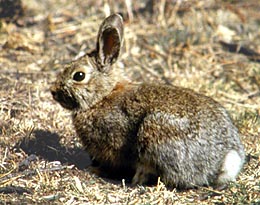
Photographer: Steven Hint
Courtesy Wikimedia
Licensed under Cc-by-sa-3.0
Hi, this is Mark Larese-Casanova from the Utah Master Naturalist Program at Utah State University Extension.
Now that snow is finally accumulating in Utah’s mountains, weekend hiking trips have come to an end. But, that means it’s time to dust off the snowshoes and skis and get back outside. We humans are lucky in that we have countless types of gear to help us adapt to almost all winter conditions.
While a fur coat might help keep mammals warm or camouflaged in winter, there are many other adaptations that also aid in winter survival. Decreased mobility in deep snow can often prevent animals from finding food, possibly causing starvation in winter.
Some animals have feet that are particularly large for their body size, which helps them travel on top of deep snow. One of the best examples of this adaptation can be found in snowshoe hares. Snowshoe hare prints are easy to spot among the spruce and fir trees- the large teardrop-shaped hind feet leave prints that look like the hare was wearing miniature snowshoes, which is how it got its name.
While some animals are adapted to walk on top of deep snow, others do their best to simply walk though it. The long, slender legs of moose help keep the majority of their bodies above the snow, minimizing the energy required to travel in winter.
Instead of walking on top of or through the snow, small mammals such as mice and voles travel under the snow. As snow accumulates, mice and voles create vast networks of tunnels on top of the ground, but under the snow. This subnivean environment is typically warmer than air temperature above the snow, and still provides access to food, such as grasses, seeds, and bark.
Short-tailed weasels, also known in winter as ermine, have a long, slender body shape that allows them to invade subnivean tunnels to prey upon smaller mammals. As long as its head can fit into a tunnel, its narrower body can follow. This adaptation comes with a price, though. Slender bodies lose heat quickly, so weasels must consume around one-third of their body weight in food each day in order to produce enough heat to survive.
So while deep powder might seem like a winter wonderland to those of us who can adapt with the right gear, other mammals continually struggle to stay warm and find food. Some, however, choose to give up the fight and sleep the winter away.
For Wild About Utah, I’m Mark Larese-Casanova.
Credits:
Images: Pending rights approval
Text: Mark Larese-Casanova, Utah Master Naturalist Program at Utah State University Extension.
Additional Reading:
Ellsworth, E. Surviving the winter: The importance of snowshoe hare foraging behavior. BEHAVE: Stories of Applied Animal Behavior. University of Idaho. Available at: https://www.cnr.uidaho.edu/range556/appl_behave/projects/hare_forage.html
Gellhorn, J. (2002). Song of the alpine: The Rocky Mountain tundra through the seasons. Johnson Books.
Lieberg, A. (2009). Charismatic minifauna. Northwest Connections. Available at: https://www.northwestconnections.org/documents/news/EOE_09feb26_Lieberg.pdf


